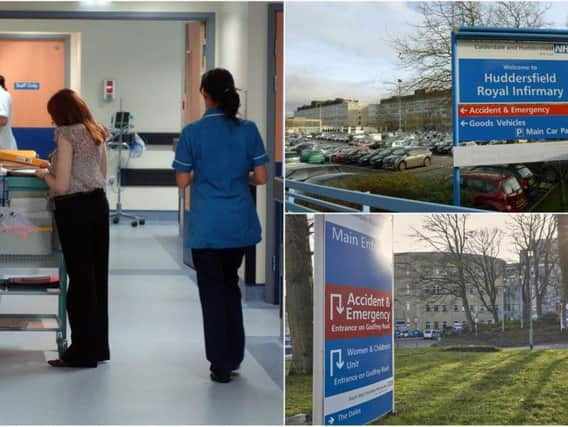Outline case approval for Calderdale Royal Hospital's £176m multi-storey car park and expansion 'by end of year’


The at times controversial changes which will affect Calderdale Royal Hospital in Halifax and Huddersfield Royal Infirmary are now in a process of review and approval by key organisations including NHS England, the Treasury and the Department of Health.
Director of Transformation and Partnerships at Calderdale and Huddersfield NHS Foundation Trust, Anna Basford, told the trust’s Board of Directors today (Thurs) the expectation was that this would be completed by December, moving the project closer to an ultimate building completion date of January 2025.
Advertisement
Hide AdAdvertisement
Hide AdIn all it is estimated around £176.5 million will be spent expanding and new build work at Calderdale Royal Hospital, including – through alternative sources of capital funding via a partnership with either a public or a commercial joint venture – an extra 600-space multi storey car park which will almost double parking capacity there.
And £20 million will be spent at Huddersfield Royal Infirmary to adapt existing buildings and address immediately the most critical maintenance work needed to enable continued use of the site and deferring new build there for at least a decade.
A&E services will remain at Huddersfield, all “blue light” ambulance patients who are in a serious condition or are expected to need hospital admission will be taken to an expanded Calderdale Royal Hospital.
To cope, additional car parking will have to be developed at Calderdale, which has 787 spaces at the moment.
Advertisement
Hide AdAdvertisement
Hide AdThe proposed multi-storey car park, probably at the front of the hospital, would provide another 600 spaces and it is envisaged another 80 spaces can be found at Dryclough Close – both would be subject to planning permission.
Developing the site would lose 134 spaces but the new total of 1,333 would be almost double the existing provision.
New build accommodation at Calderdale will include a learning and development centre.
Developments will be designed to enable optimal use of new technology and digital communications to enable real time review and advice on patients’ care to be provided by specialist staff at either hospital site and in the community.
Advertisement
Hide AdAdvertisement
Hide AdKey areas that will need investment there are upgrading Accident and Emergency (A&E) resuscitation, ward areas, windows, stone cladding, air handling, pipe work and drainage as well as addressing fire safety and asbestos removal issues.
Bed capacity will remain the same at around 840 across the two sites, including 18 – possibly rising to 22 – Intensive Care Unit beds, and a total of 19 operating theatres, 11 at Calderdale and eight at Huddersfield, will be in place.
The report said: “The total number of hospital beds will remain broadly as they are now whilst services are developed in the community and demonstrate a sustainable reduction in the demand for in-patient hospital care.”
Trust Chief Executive Owen Williams reiterated the point that bed numbers would only be reduced as quality healthcare in the community was developed further.
Advertisement
Hide AdAdvertisement
Hide Ad“This cannot take place separately from what needs to happen in provision in community services.
“We have as much commitment to what is happening outside the hospital as to what is happening inside the hospital,” he said.
Earlier this year Calderdale and Kirklees Joint Health Scrutiny Committee had heard the aim was to develop integrated care and support to get people home more quickly, reducing the need for high numbers of beds.
Mr Williams said it had to be made really clear bed numbers were not going to be reduced until healthcare in the community had been developed sufficiently.
Advertisement
Hide AdAdvertisement
Hide AdNHS bosses first proposed to bulldoze Huddersfield Royal Infirmary, which has an estimated £95 million maintenance backlog, and replace it with a smaller site.
But the plan met with protests and legal action from the campaign group Hands off HRI, and last year former health secretary Jeremy Hunt ordered a re-think by an independent panel.
Concerns included longer journey times to hospital for A&E patients if Huddersfield no longer had a full A&E department.
New plans were then published which scrapped the HRI demolition and said 24-7 emergency care would be retained in both towns.
Advertisement
Hide AdAdvertisement
Hide AdMr Williams said a number of board members were really keen to see how technology could be used to better provide and deliver care to local people.
Financially, the strategic outline case only carried forward three scenarios from 12 considered – business as usual, implementing minimum changes or the preferred intermediate option as outlined, which is the only one ticking all the criteria boxes.
The economic case analysis reaffirms the case for change, that developing Calderdale Royal as the unplanned care hospital, with a planned hospital and emergency care centre development at Huddersfield provides better value for money than either the business as usual or doing the minimum options.
Further evaluation of risks and benefits will be carried out as the reconfiguration business case develops.
Advertisement
Hide AdAdvertisement
Hide AdHealth bosses hope the plan will secure the long-term future of the NHS trust, which is around £43 million in deficit.
They say the changes are needed to provide for a growing population and more people living with complex health conditions.
The trust pledges to continue engaging and involve staff, local people, campaign groups, key stakeholders including Calderdale and Kirklees Councils and the Joint Health Scrutiny Committee from this spring in developing the next steps.
If approval for the strategic case is granted by December it is envisaged the outline business case could be completed by October next year, the final business case made by September 2022, building work starting in January 2023 and building completed by January 2025.